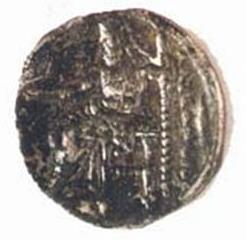This silver drachma coin struck in 323 B.C.E. is among the artifacts that provided evidence for the dating of the “cigarette” scroll.
The “cigarette” scroll, found in a cave at Ketef Jericho rolled up into a cigarette-like tube, has helped to substantiate the science of paleography. This Aramaic document is a ledger, listing on one side the names of people who borrowed money and recording the loans’ repayment on the other. Orginally, it was thought that the scroll was deposited in the cave in 343 B.C.E., when Jericho was destroyed by the Persians. But the eminent paleographer Frank Moore Cross, after studying the document’s characters, argued that it must date later than another Aramaic document, Wadi ed-Daliyeh, which dates to 335 B.C.E. Cross was proved right when artifacts found near the Ketef Jericho cave—including a silver drachma coin struck in 323 B.C.E. (see photograph)—indicated a later date. It is now believed that the scroll dates to around 312 B.C.E., when Ptolemy I invaded Judea and Samaria and sent the inhabitants into exile in Egypt.
“Defusing Pseudo-Scholarship- Some Paleographic Success Stories,” BAR Mar-Apr 1997.
